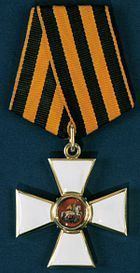Type Military Order Status Active | Awarded for Distinction in Combat | |
 | ||
Eligibility Top and Senior Military Officers Established November 26, 1769, revived on March 20, 1992 | ||
Order of st george
The Order of Saint George (Russian: Орден «Святого Георгия») is today the highest purely military decoration of the Russian Federation. Originally established November 26, 1769 as the highest military decoration of the Russian Empire by Empress Catherine the Great and existed up to the 1917 Russian Revolution. It was revived in the Russian Federation on August 8, 2000 by Decree №1463 of the President of Russia. The current award criteria were amended on September 7, 2010 by Presidential Decree 1099.
Contents
- Order of st george
- The order of st george investiture ceremony
- Statute of the Imperial St Georges Order
- Description of the Order
- Recipients of the Order second class
- Recipients of the Order fourth class
- References
The order of st george investiture ceremony
Statute of the Imperial St. George's Order
The current Order of Saint George is awarded to highest and senior military officers for the conduct of military operations to protect the Fatherland from attack by an external enemy which resulted in the complete defeat of the enemy, for the execution of combat and other operations in other states aimed at restoring international peace and security, or for being a model of military science with feats that exemplify military prowess; the Order is also conferred upon officers who were previously awarded state awards of the Russian Federation for distinction in combat.
Description of the Order
The Order of Saint George is divided into four classes, from the First Class to the Fourth class; the highest degree being the Order First class. The four classes are awarded sequentially from the fourth to the first. These four classes are individually identified by the size and manner of wearing the two principal insignia of the Order, the cross and the star.
Cross: A white enamelled cross pattée with a central medallion bearing the image of Saint George on horseback slaying the dragon. The cross measures 60mm across in the case of the Order first class and is worn on a sash in the colours of Saint George (orange and black). The same 60mm cross is worn around the neck on a 45mm wide ribbon also in the colours of Saint George for the Order second class. The cross is 50mm across for the Order third class and is also worn around the neck but from a 24mm wide ribbon in the same colours. The Order fourth class is a 40mm cross worn on the left breast hanging from a pentagonal mount covered with a 24mm wide ribbon of Saint George.
Star: A four-pointed silver gilt star with a gold central medallion bearing the cipher of Saint George "SG" topped by a crown and surrounded by a black enamelled band bearing the motto of the order "For Service and Bravery" ("Za Sluzhbu i Khrabrost"). The star is worn on the left breast for both the Order first and second classes.
Ribbon: The ribbon of the Order of Saint George is orange with three black stripes, commonly called "George's Ribbon". It symbolises fire and gunpowder: the Russian "colors of military glory", and is also thought to be derived from the colours of the original Russian imperial coat of arms (black eagle on a golden background). It was subsequently associated to the colors of the Russian Guard units. Unlike the other classes, the Order of Saint George fourth class can be awarded to junior officers while the rest is for senior and flag officers.
The ribbon bar for the Order first class is adorned with a miniature golden star. The ribbon bar for the Order second class is adorned with a miniature silver star. The ribbon bar for the Order third class is adorned with a miniature white cross. The ribbon bar for the Order fourth class has no device.